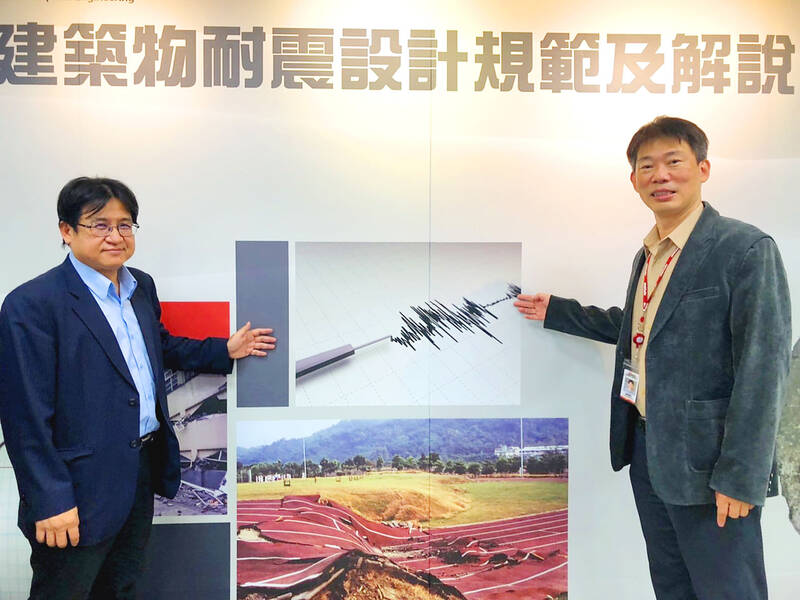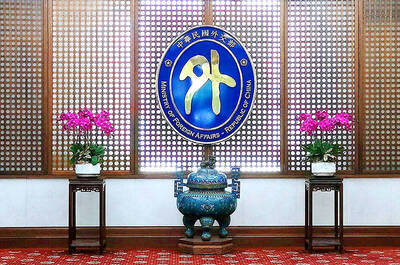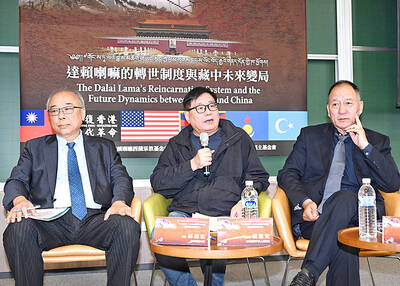The Ministry of the Interior yesterday outlined recent changes to building codes that include new mandates to reinforce structures susceptible to earthquakes.
The amendments to the Building Earthquake Resistance Design Regulations and Explanation (建築物耐震設計規範及解說) went into effect on Oct. 1.
Many tall buildings in Taiwan have been improperly modified to house street-level shop fronts, which can compromise structural integrity during a quake, National Center for Research on Earthquake Engineering Director-General Chou Chung-che (周中哲) told a news conference.

Photo: Yang Yuan-ting, Taipei Times
Illegal constructions on top of buildings are another vulnerability common in buildings throughout the nation, he said.
The new rules require susceptible buildings to install ad hoc structural reinforcements to boost safety until a long-term solution can be implemented, be it an overhaul or demolition, Chou said.
The ministry and the center have ensured that every vulnerable student dormitory up to the junior-high school level has been reinforced, he said, adding that they are now focusing on hotels, markets and other public buildings.
People who are concerned about the structural integrity of the building they live in can contact the center for help, especially for structures that have exposed pillars, he said.
The new rules revised quake resistance standards for structures near fault lines to include the ability to withstand shallow earthquakes, he added.
This means new buildings near fault lines must be 20 to 30 percent more resistant to quakes than before, which translates into an estimated 5 percent increase in construction costs, Chou said.
The center is collating information on land liquefaction cases to map risks nationwide while fine-tuning testing protocols and quality-control procedures for base isolation and quake reduction components, he said.
People are encouraged to use government subsidies to check the quake resistance of their residential buildings, Construction and Planning Agency Director-General Wu Hsin-hsiu (吳欣修) said.
“The safety of your house is far more important than its real-estate value,” he said.

ALIGNED THINKING: Taiwan and Japan have a mutual interest in trade, culture and engineering, and can work together for stability, Cho Jung-tai said Taiwan and Japan are two like-minded countries willing to work together to form a “safety barrier” in the Indo-Pacific region, Premier Cho Jung-tai (卓榮泰) yesterday said at the opening ceremony of the 35th Taiwan-Japan Modern Engineering and Technology Symposium in Taipei. Taiwan and Japan are close geographically and closer emotionally, he added. Citing the overflowing of a barrier lake in the Mataian River (馬太鞍溪) in September, Cho said the submersible water level sensors given by Japan during the disaster helped Taiwan monitor the lake’s water levels more accurately. Japan also provided a lot of vaccines early in the outbreak of the COVID-19 pandemic,

Kaohsiung Mayor Chen Chi-mai (陳其邁) on Monday announced light shows and themed traffic lights to welcome fans of South Korean pop group Twice to the port city. The group is to play Kaohsiung on Saturday as part of its “This Is For” world tour. It would be the group’s first performance in Taiwan since its debut 10 years ago. The all-female group consists of five South Koreans, three Japanese and Tainan’s Chou Tzu-yu (周子瑜), the first Taiwan-born and raised member of a South Korean girl group. To promote the group’s arrival, the city has been holding a series of events, including a pop-up

The Ministry of Foreign Affairs (MOFA) yesterday voiced dissatisfaction with the Comprehensive and Progressive Agreement for Trans- Pacific Partnership (CPTPP), whose latest meeting, concluded earlier the same day, appeared not to address the country’s application. In a statement, MOFA said the CPTPP commission had "once again failed to fairly process Taiwan’s application," attributing the inaction to the bloc’s "succumbing to political pressure," without elaborating. Taiwan submitted its CPTPP application under the name "Separate Customs Territory of Taiwan, Penghu, Kinmen and Matsu" on Sept. 22, 2021 -- less than a week after China

TEMPORAL/SPIRITUAL: Beijing’s claim that the next Buddhist leader must come from China is a heavy-handed political maneuver that will fall flat-faced, experts said China’s requirement that the Dalai Lama’s reincarnation to be born in China and approved by Beijing has drawn criticism, with experts at a forum in Taipei yesterday saying that if Beijing were to put forth its own Dalai Lama, the person would not be recognized by the Tibetan Buddhist community. The experts made a remarks at the two-day forum hosted by the Tibet Religious Foundation of His Holiness the Dalai Lama titled: “The Snow Land Forum: Finding Common Ground on Tibet.” China says it has the right to determine the Dalai Lama’s reincarnation, as it claims sovereignty over Tibet since ancient times,